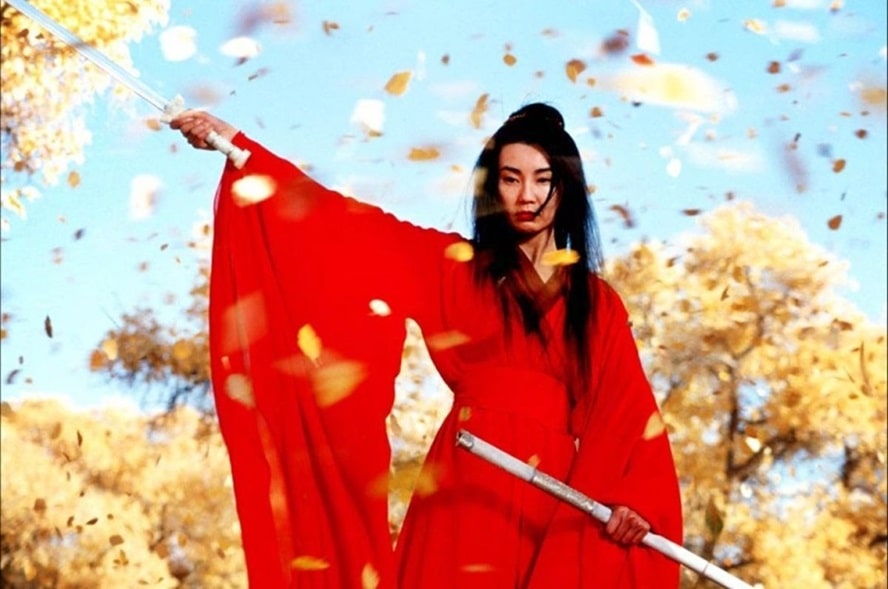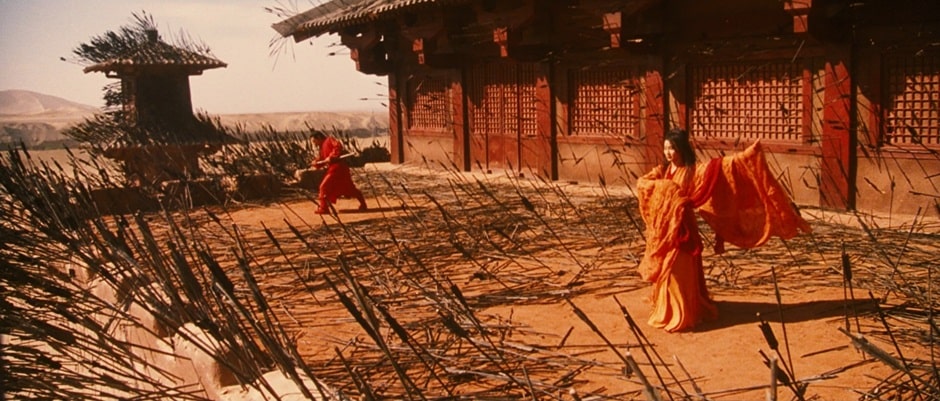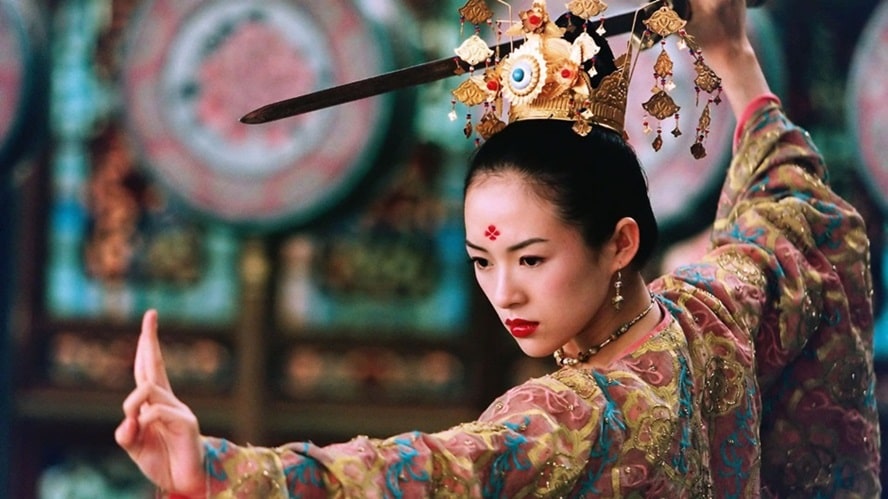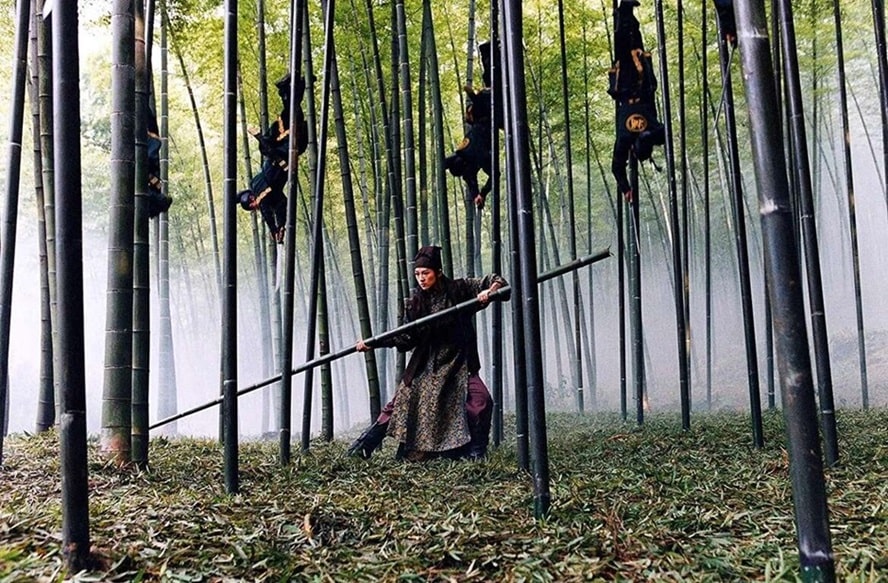Ellsworth’s Cinema of Swords: Zhang Yimou
Hero (China/Hong Kong, 2002)
The Hong Kong cinema industry’s success as an action-film factory for 50 years starting in the 1960s has meant that most of the Chinese-language movies covered by Cinema of Swords originated there. However, once mainland China shook itself free of its painful Cultural Revolution, its own film industry began to reassert itself. Zhang Yimou was one of the new directors of the so-called “Fifth Generation” that emerged in the ‘80s and ‘90s. A native of Xi’an in remote western China, Zhang had a distinctive eye for landscapes and most of all color, and his early films were acclaimed dramas telling stories of the Chinese middle and working class, movies such as Red Sorghum (1988), Ju Dou (1990), and Raise the Red Lantern (1991).
What primarily interests us, of course, is Zhang’s work in the wuxia genre, which he took up after the success of Ang Lee’s Crouching Tiger, Hidden Dragon (2000). Zhang’s Hero (2002) and House of Flying Daggers (2004) are big-budget productions with leading stars such Jet Li and Zhang Ziyi, but it’s really Zhang’s incredible art and action direction that make them instant classics.
Zhang stuck with the genre for one more film, 2006’s Curse of the Golden Flower (patience, we’ll get there!), before his status as a celebrity filmmaker drew him away to such projects as directing the visual presentation of the 2008 Beijing Olympics. His return to wuxia with The Great Wall in 2016 was not auspicious, alas. But we can still enjoy his classics from 2002 to 2006 — again and again, in the case of this reviewer.
Hero
Rating: *****
Origin: China/Hong Kong, 2002
Director: Zhang Yimou
Source: Miramax DVD
This epic wuxia fable may be the most beautiful swordplay movie ever made. And yet it sat on the shelf of its American distributor for several years and almost didn’t get a US theatrical release until it was endorsed by Quentin Tarantino, then at his most influential as a cinematic tastemaker.
Though shot with thousands of extras, the film really has only six characters, and its story is simple — but it isn’t straightforward, being told in five chapters, each of which adds to and reveals more about these characters’ history and relations. It’s set in China’s Warring States period, when the King of Qin (Chen Daoming) is attempting to unite the country’s seven provinces by force of arms.
Resistance comes in the form of assassination attempts by three renowned martial artists: Long Sky (Donnie Yen), Flying Snow (Maggie Cheung), and Broken Sword (Tony Leung), whose abilities are so fearsome that the king has slept in armor for ten years. But then one of the king’s lowly magistrates, an orphaned swordsman known only as Nameless (Jet Li), comes to the capital to report that he has slain the three assassins, bringing their signature weapons with him as proof.
Nameless is admitted to the presence of the king, where he recounts how he slew Long Sky in a duel, and then helped Broken Sword’s adoring aide Moon (Zhang Ziyi) drive a wedge of jealousy between the lovers Flying Snow and Broken Sword, making them vulnerable to defeat. The king listens in admiration, but then picks apart Nameless’ story and presents him with a different interpretation. Nameless admits the king is right and tells a third version of events — which the king, now openly skeptical, is again able to demolish. And finally, the real truth comes out.
Let’s get right to the flowing-silk-draped elephant in the room: this movie is flat-out, drop-dead gorgeous. Each chapter is filmed in a different rich, saturated color palette, gray, red, blue, green, and white, so the film resembles an intense fever dream, solid but beyond reality. The wuxia combats, and there are plenty of them, are intricate sword dances exaggerated by the fabulous, flowing fabrics of the duelists’ extravagant costumes. The wire work is subtle, the combatants launching themselves into the air with floor vaults and off-wall kicks that make their dreamlike flight somehow credible. And the locations in northern and western China where the exterior scenes are shot are beyond stunning in their natural beauty.
It isn’t flawless. The performances of the six leads are excellent or even better, but despite the best efforts of director and co-writer Zhang Yimou to give them weight and significance, the characters aren’t particularly deep, and they’re all too stoic to be very engaging, the inevitable doomed romance notwithstanding. The story thinks it has important things to say about heroism and sacrifice, but there’s nothing particularly new or inspiring in how it says it, which leaves the ending a little flat. And you’ll have to make up your own mind about its seeming endorsement of tyranny-for-the-greater-good.
But that said, there are scenes in Hero so striking that you won’t be able to get them out of your head afterward; don’t blame me if you find yourself going back to watch parts of it again, possibly many times over. It’s that good.
House of Flying Daggers
Rating: ***** (Essential)
Origin: China/Hong Kong, 2004
Director: Zhang Yimou
Source: Sony Pictures Classics DVD
This wuxia romantic tragedy is just as visually gorgeous as its predecessor, Zhang Yimou’s Hero (2002), but in a different way, shot largely in outdoor settings that are as color-drenched as Hero’s stages, but in settings of nature rather than artifice. Ching Siu-tung reprises his role as action choreographer, and the balletic fights in Flying Daggers are as awe-inspiring as those in Hero, albeit less exaggerated and more restrained, more human and less superhuman.
The corrupt Tang Dynasty is opposed by a people’s resistance, the House of Flying Daggers, and Imperial Captain Leo (Andy Lau) is given just ten days to discover and capture or kill the rebels’ leader. He tells his lieutenant, Jin (heartthrob Takeshi Kaneshiro), that he believes a courtesan at the Peony Pavilion is an agent of the Flying Daggers and assigns Jin to deploy his skills as a ladies’ man to investigate her. The courtesan, a young dancer named Mei (the fabulous Zhang Ziyi), is blind, and when she fights off Jin’s advances, it gives Leo an excuse to phony-arrest Jin and detain Mei as well. Then Jin liberates Mei in a bogus jailbreak and they escape into the wilderness. The plan is that Mei will lead Jin — and Leo, in covert pursuit — to the lair of the Flying Daggers. But all involved are young and hot-blooded, and love throws a wrench into everyone’s plans.
And that’s just about the whole story: three main characters, romance, treachery, and a deadly running pursuit punctuated by ambushes shot in spectacular forest environments in China and Ukraine. And it never pauses for a moment and is so stunning, you can’t look away. All three leads start out pretending to be something they’re not, but the challenges of the pursuit, lethal and emotional, gradually strip away their masks and defenses until they see each other’s true selves, their hearts in their eyes, their fates in each other’s hands.
It’s impossible to say more without spoilers, and to spoil this film would be a crime. Do. Not. Miss. It.
Where can I watch these movies? I’m glad you asked! Many movies and TV shows are available on disk in DVD or Blu-ray formats, but nowadays we live in a new world of streaming services, more every month it seems. However, it can be hard to find what content will stream in your location, since the market is evolving and global services are a patchwork quilt of rights and availability. I recommend JustWatch.com, a search engine that scans streaming services to find the title of your choice. Give it a try. And if you have a better alternative, let us know.
Previous installments in the Cinema of Swords include:
Zatoichi at Large
Invitation to a Keelhauling
Sequel Debacle
Deuces Wild
Beware of Greeks
Peak ‘90s Wuxia
Ashes of Time
Consider the Rapier
They Seek Him Here…
The Darkness Before the Dawn
Young Horatio Hornblower
Two-Thirds of a Miracle
Wolves and Scorpions
LAWRENCE ELLSWORTH is busily promoting the Cinema of Swords compilation from Applause Books, a volume that was born right here at Black Gate! That book, out now, covers swordplay movies up through the ‘80s, but Ellsworth is continuing with new material for a Volume Two and is now working his way up through the 2000s. These later reviews are being published weekly on his new Cinema of Swords Substack blog, at cinemaofswords.substack.com.
Meanwhile, Ellsworth soldiers on at his mega-project of editing and translating new, contemporary English editions of all the works in Alexandre Dumas’s Musketeers Cycle; the seventh volume, Court of Daggers, is available now as an ebook or trade paperback from Amazon, while the eighth, Shadow of the Bastille, is being published in weekly instalments at musketeerscycle.substack.com. His website is swashbucklingadventure.net. Check them out!
(Ellsworth’s secret identity is game designer LAWRENCE SCHICK, who’s been designing role-playing games since the 1970s. He now lives in Dublin, Ireland, where he works for Larian Studios and was Principal Narrative Designer for the Dungeons & Dragons videogame Baldur’s Gate 3.)




eughh, always thought these two flicks are cringey, together with aformentioned ang lee flicks as well. its like they are made for the western audience. its all beautiful with gorgeous colors blablabla but the story is meh and the stunts are borderline outrageous. growing up with 90s wuxia, i was dissapointed.
This reminds me that I’m long past due to rewatch Zhang Yimou’s Shadow, which showed that he could make films just as gorgeous as Hero or House of Flying Daggers while using primarily a black & white palette. And probably Curse of the Golden Flower, just for good measure.
Hero was good but I loved House of Flying Daggers. Especially the end scene which took me by surprise because I didn’t know anything about the movie before watching it.
I started Curse of the Golden Flower but never got to finish it. It didn’t grab me like the first two and a friend said he loved it so I gave it away without finishing it.
House of Flying Daggers was an OK movie, fun to watch on the rare and desirable Saturday nights one has a whole pizza to oneself. The fight choreography is pretty in the same way that that of Drunken Master is hilarious. But Hero?
I wanted to like Hero, because five-act stories are usually better than three-act stories, but it felt so empty. Maybe it was the lack of dimensional characters, as you mentioned. Maybe it was just the fact that it was about two men lying to each other the whole time. Maybe it’s that a movie titled “Hero” seems to have no heroes in it. The fight choreography that could redeem it, from the first court scene to the final arrow silhouette seems… like it would be more interesting if Jill Bearup and her compatriots were analyzing it.
No. If a movie night calls for a Hero-style story, Strings will spin in my player. If it calls for color, then Amelie. Hero gets consigned to the dustbin.
I loved Crouching Tiger, Hidden Dragon, and I watched both Hero and House of Flying Daggers. I recall liking one and being disappointed by the other, and I suspect it was House of Flying Daggers that I liked — the still look familiar.
Both are gorgeous films. I appreciated Hero’s ending, but I loved House of Flying Daggers. Despite the story kind of petering out at the end, the climatic battle reminded me so much of Frazetta’s “Frost Giants” that I couldn’t help but walk away smiling.
I have an opinion about the art style;
House of Flying Daggers could be painted most frames Ukiyo-E style – the lush rich Japanese woodcut things that inspired western Impressionist art. Hero is meant for mostly Chinese style brush painting with single color accent – but almost every frame could be painted this way. Serious, if I had nothing better to do I could work out a projection table and do one sheet of rice paper after another with the traditional ink and paints and make some insane animated masterpiece to the sound of the movie. This might be a good use of AI someday soon – imagine Hero in Chinese Brush paintings with color style…!? Shadow is meant to be a more complex, dark story but parts of it could be painted with deliberately murky black and white and this ideally by a realist fantasy artist like Luis Royo – who did his own orientalist thing “Dead Moon”… for the film’s dark theme of moral ambiguity and that the only thing real was meant to be the actions of people.
Just my opinion – have you seen “Shadow” yet?